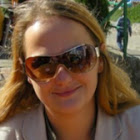For anyone visiting Granada, Montefrio is a must-visit destination. It’s an authentic white village located one hour’s drive outside Granada city. In 2016, National Geographic recognized the view of Montefrio village as one of the top ten most picturesque views of villages in the world. The traditional white houses that line its hills and its mediaeval sandstone church at the top of a very steep hill were what impressed National Geographic.
Indeed, when you drive from Granada to Montefrio, the view of the Moorish castle, the white houses, and the round church is one that will prompt you to stop and take a photo. In the main square, you can absorb the lively atmosphere of the village, over a cold caña, a small beer, and complimentary tapas. Once refreshed, you will be ready to climb the steep hill to see the ruins of the Moorish castle that crowns the village and admire the stunning views of the surrounding olive hills and local architecture.
The following post is an excerpt from a new book set in Granada province entitled The Crinkle Crankle Wall: Our First Year in Andalusia by Sabina Ostrowska. In this fragment, Sabina and her sister’s family, who are on holiday in Montefrio, climb up a steep hill to explore Montefrio’s Moorish past.
Montefrio made National Geographic 2016 Top 10 most picturesque views of villages in the world | Sabina Ostrowska
Conquering the Fortress in Montefrio
The day after my sister’s arrival, I took them on a family walkabout around Montefrio. It had now been a year since we moved to Andalusia to start a new life and because of the endless renovations and work on the house, it was the first time that I was going to explore our little village in more detail, walk its streets and observe it from a tourist’s perspective. In truth, it’s not the most beautiful village in the world, especially when viewed from the inside, but like the rest of the region, it’s down-to-earth and real.
The first thing that strikes any Central or Northern European when walking into a pueblo blanco, like Montefrio, is that everyone on the streets greets you, and if you greet them back and smile, they smile back at you. What’s more, the people who you pass on the street like to comment on your current situation in life. If you’re carrying a heavy bag, they will say, “¡Qué pesado!”. If it’s a hot summer day, they will inform you, as if you were oblivious to the sweat pouring down your own face, “¡Qué calor!”. If it’s a cold January day, strangers on the street will make you aware of it “¡Qué frio!”.
It makes you feel welcome and at home. You can walk up to any one of the old men who stand at the curb outside the bars in the village and strike up a conversation – and they will love nothing more than to chat to an outsider who is visiting their town. The Spaniard’s talent for talking for hours to complete strangers about nothing should not be underappreciated. It is one of the qualities, I believe, that makes them one of the healthiest nations in Europe. Being able to look your neighbours or passers-by in the eye and talk openly about anything that comes to your mind creates a strong sense of community and makes you feel happy about your place in the world.
Montefrio, the famous view of the village from the Mirador | Sabina Ostroswska
Hot and bothered
By the time we reached the round church, which is situated on the main square, Kosma started to insist that he was not able to walk anymore. We were all, in fact, getting hot and bothered, and single droplets of sweat started to appear on my sister’s almost transparent – from months of sun deprivation – temples. Even though it was early September, the temperature in the direct sunlight must have been around thirty-five degrees or more. Despite the heat bearing down on us, Michal picked Kosma up and like a modern-day St. Christopher put him on his shoulders. With this load on his shoulders and my sister carrying sleeping Zoja in a baby carrier on her chest, we started the steep climb up the hill to see the ruins of the Moorish castle that acts as a sentinel for the peaceful village of Montefrio.
This was the second time that I was to visit the ruins since we had moved to Andalusia. The first time we went up the hill was the previous February when the temperatures outside were refreshing, and the wind cooled us off on the climb. At that time, the almond trees that cover most of the hill all the way up to the old castle were in full blossom, and it was a spectacular sight. Almond blossoms, I dare say, are far superior to cherry blossoms. While I love the sight of both – the cherry orchard near our house usually blossoms in April – I find almond blossoms much sturdier and more robust than the fluffy and fragile cherry blossoms.
Steep and narrow streets of Montefrio | Sabina Ostrowska
The long way round
As I was reminiscing on the beauty of different blossoms, I must have missed the correct turn, and I quickly realized that we were taking the longer and the steeper way up to the castle. I did not recall having to walk up through the very narrow and windy streets of the gipsy quarter, called Solana. I vaguely remembered that this was the way out of the castle and not the castle’s entrance. My doubts were quickly confirmed by an old man sitting on a tiny patio outside his house, listening to flamenco and mending an old potato sack.
“Are you going to the castle?” he shouted at us in Spanish.
Since I was the only one who understood the question, I confirmed. “Si.”
“It’s the wrong way. You should go back to the square and turn right.”
“Si, si.” I nodded at him in agreement and smiled as if we were just discussing the weather.
“What did he say?” My family was in awe that a Spanish native would speak to them on the street.
“He said that it’s very hot today.”
My sister and her partner looked at the old man, smiled at him and repeated several “si, sis” in a row.
“This is too steep to carry the children this way.” He seemed concerned.
“Yes, you’re right.” I kept my sunny demeanour and turned to my sister to translate.
“He says that it’s not far from here.”
Both Michal and Beata seemed relieved to hear this. The extra loads that they were carrying must have been weighing them down by now, but they didn’t want to moan. Fortunately, Robert wasn’t with us, or he would have felt compelled to argue with me about the correct route to the castle. I took my phone from my back pocket — the only thing I was carrying — and suggested a quick photoshoot on the narrow white streets. They both agreed as it offered a short break from the steady climb up the hill.
After a quick photo session and with their spirits lifted with the good news that the end of the climb was not too far, we continued for another twenty or so minutes. While the ruins were not far, the steep climb that we were following due to my mistake seemed interminable. After dodging dog poo and the disconcerting stares of several defensive gipsy housewives who did not seem too happy that their doorsteps were on the main tourist path, we reached a crossroad.
“Look, there’s a chicken,” Amelia pointed in the direction of a lonely chicken wandering the street.
I hoped we did not have to cross paths with it, as I have a severe phobia of birds, and I would rather go down and choose a new path than have to walk past a chicken. We stood at the crossroads for a few minutes wondering which way to go. We could see the castle walls hanging above us; we just did not know which way would be the least draining to get there. Amelia — our teenager —spotted a sign labelled ‘Castillo’. It was about ten centimetres long and three centimetres wide and attached to a sidewall of a house.
“Thank God,” I thought. The sign was pointing to a different street than the one the chicken was patrolling.
I was beginning to worry that we would never find the entrance to the fortress. As we were nearing the fort’s gate, Kosma fell asleep on his father’s shoulders, and Zoja woke up and started to whimper in her carrier. I knew by now that she never whimpered for too long and that soon her soft cries were going to turn into a hysterical fit.
“We’ll see you at the top,” I said, and on command, Amelia and I rushed to the top of the stone steps to escape the cries of the teething baby dragon.
It was an unfortunate coincidence that Zoja started to teethe as soon as they landed in Barcelona a few days before. It was her first tooth, and it was now coming out with a vengeance and making everyone’s life miserable. While Amelia and I stood at the top of the old ruins admiring the spectacular panorama, we tried our best to ignore the screams that we heard in the distance.
Amelia was finishing a session of artistic selfies with cacti when her father and my sister appeared at the walls. Michal was now carrying the screaming Zoja, and Kosma was holding my sister’s hand and sobbing because she woke him up and told him to walk by himself. Like any family travelling with small kids, they were all in foul moods, regretting ever leaving their apartment in Gdańsk. The sun was now blazing and burning their pale faces. The extreme hike made the sunblock stream down their faces and irritate their eyes. I was not sure if their eyes were watering from the fatigue, stress, or sunblock, but I decided not to broach the subject. I felt a bit guilty for putting them through this ordeal and thought that a short rest inside a cool stone church might lift their spirits.
“Let’s see inside the church,” I suggested.
The view of Montefrio village from the top of the church tower | Sabina Ostrowska
Downhill on the way home
We walked inside and were greeted by a cold blast. It was like diving into an ice cube. My company marched directly to the benches set out for tourists to sit on and watch a film about the fortress. They all sat down, relieved to find a place in Andalusia that was not as hot as hell. I paid the exorbitant fee of five euro per person and thought of it as my penance for lying to everyone about the directions.
The cold air seemed to calm the babies down. Zoja was now just whimpering, and sobbing and Kosma was sulking. Because the Spanish love children – they are never bothered with how loud or obnoxious they are – the museum’s caretaker was not bothered with such behaviour. In fact, since we were quite a large group of tourists for Montefrio, she decided that she should entertain us with the film about the Moorish ruins and the Christian church.
She dimmed the lights and turned the entertainment on. The darkness and the musical crescendo combined with the dramatic shouting from the Moors defending their besieged castle and fighting to save their lives seemed to exert a calming effect on my niece’s tooth. Kosma, on the other hand, became hysterical and had to be taken outside to calm down. While Kosma and Michal stayed outside, we enjoyed the rest of the drama in relative peace. The medieval mayhem, the yelps of the dying Christian knights, and the apocalyptic hollers of the Moors running away from the burning castle seemed nothing in comparison to Zoja’s ability to create lachrymose chaos. The ten minutes of ‘peace and quiet’ seemed to rejuvenate my sister, and as the film ended, she suggested that we climb to the top of the church’s tower.
With Kosma now fully calmed and Zoja asleep again, we ascended the church tower and admired the breathtaking views of Montefrio and the olive hills surrounding it. On the way back, we followed the route that we were supposed to have taken on the way up. It was created by centuries of villagers walking up to the church for Sunday Mass; it had a gradual incline and was well shaded by trees.
“This is a very nice route and easy to walk,” Michal observed and looked at me suspiciously.
I pretended that I didn’t hear him, and we walked cheerfully down the hill.






